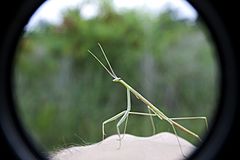Brunneria borealis facts for kids
Quick facts for kids Brunneria borealis |
|
|---|---|
 |
|
| Scientific classification |
The Brunneria borealis, also known as Brunner's mantis or northern grass mantis, is a special type of praying mantis. It lives in the southern parts of the United States. What makes this mantis unique is how it has babies. It's the only mantis known to reproduce without any males! All the mantises are female.
What Does It Look Like?
The Brunner's mantis is a long, green insect. It has the typical strong front legs that mantises use to catch their food. Adult mantises have small wings. They probably cannot fly. These mantises can grow to be about 77 mm (3 in) long. That's about the length of a large paperclip!
Where Does It Live?
The B. borealis mantis is found naturally in the southern United States. It lives from the Atlantic Ocean all the way west to Texas. You can find it in states like North Carolina, Georgia, Florida, Alabama, Louisiana, and Texas.
These mantises like specific places to live. In Austin, Texas, they were found on the flowers of a plant called the slender aster. In Cedar Creek, Texas, they were found in meadows with little bluestem grass. They are hard to spot during the day. But you might see them climbing among the grasses at night.
How Does It Live?
This mantis has a very interesting way of having babies. All the adult mantises are female. They lay their eggs without needing a male. This special way of reproducing is called parthenogenesis.
The female mantis protects her eggs in a special case called an ootheca. It's like a foamy, protective shell. In most mantis species, each baby mantis comes out of its own small hole in the egg case. But for the Brunner's mantis, the egg case has one pointed end. All the baby mantises come out through this single opening.
The baby mantises look a lot like the adults. As they grow, they shed their skin several times. This process is called moulting.
Mantises are usually ambush predators. This means they wait quietly for their food to come close. Then they quickly grab it. We don't know a lot about what this mantis eats. But because of its size, it probably eats grasshoppers. It also enjoys eating slender walkingsticks that live in the grass. These walkingsticks don't have many ways to defend themselves against the mantis.


